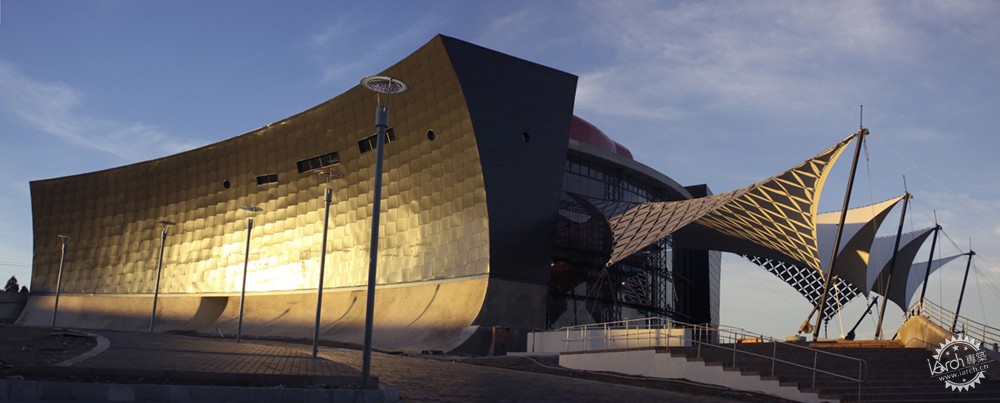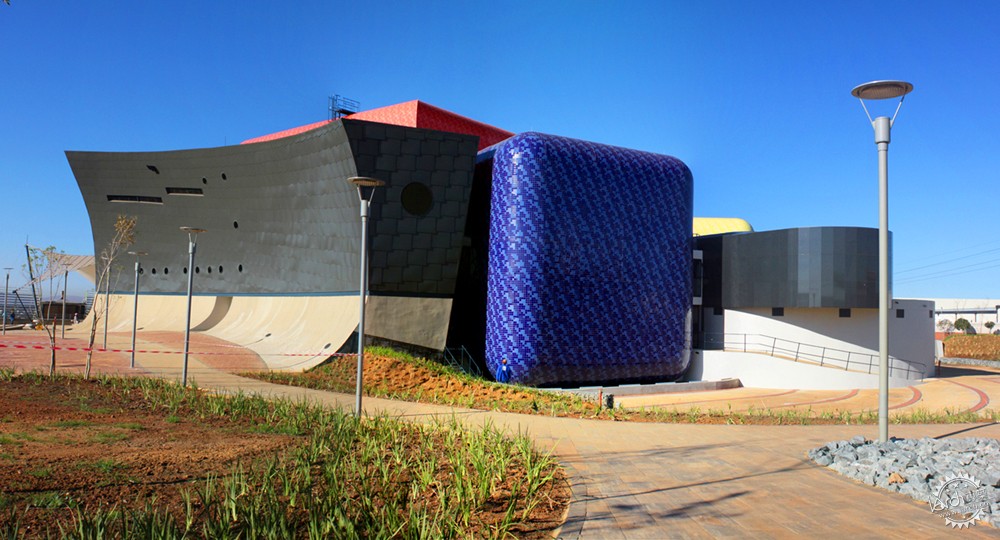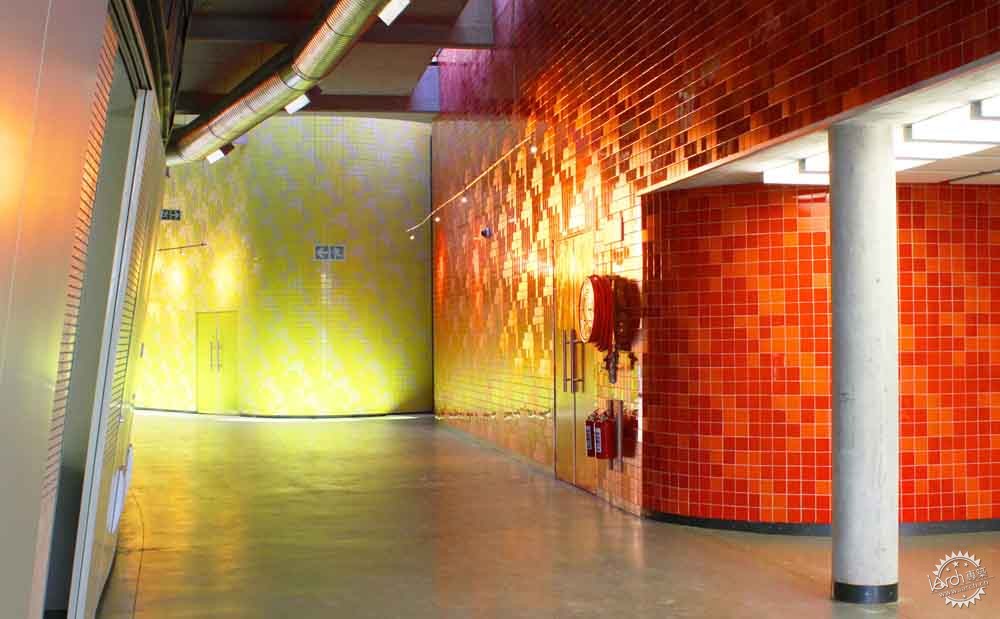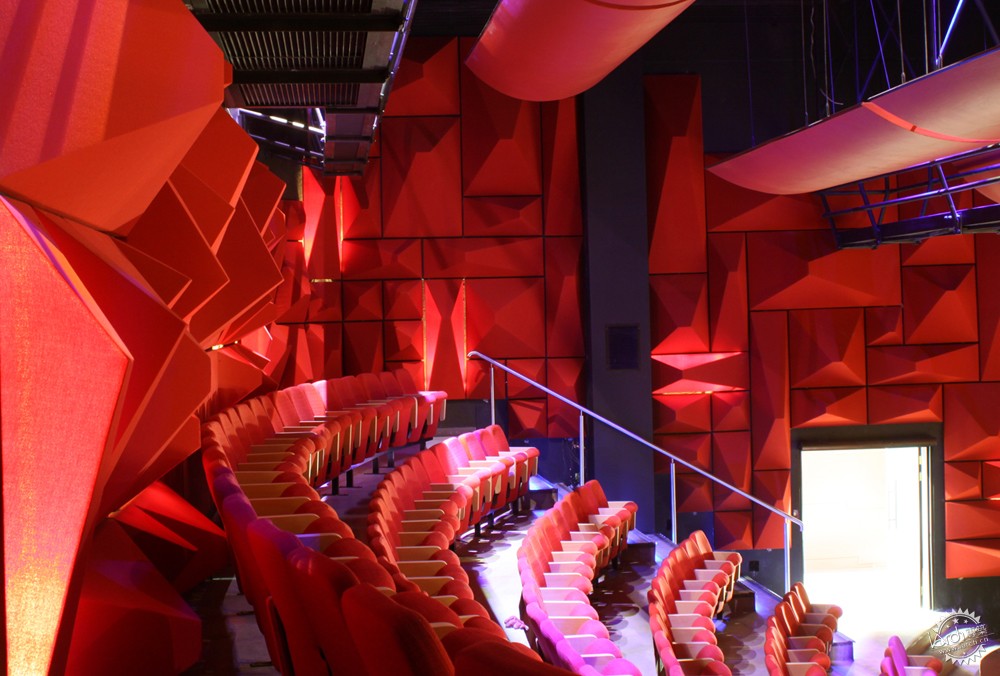
特别鸣谢翻译一组5号 刘政和提供的翻译,译稿版权归译者所有,转载请注明出处
A versatile venue for the advancement and sharing of arts and culture in the area
一个多彩场地的进步以及艺术和文化分享的地区
The Soweto Theatre is in the heart of the culturally rich Jabulani CBD precinct Soweto, in Johannesburg, South Africa. The precinct is being redeveloped by the City of Joburg Property Company SOC (JPC) into a high density, mixed use and vibrant neighbourhood comprising over 200 000m2 of new commercial and residential development.
Soweto的剧院是在CBD选区索韦托,在南非约翰内斯堡。选区正在被市政府的约堡物业公司SOC(也是)变成一个高密度、混合使用和充满活力的地区包括超过200 000平方米的新商业和住宅发展区。

The objectives for this project were to provide a fitting and versatile venue for the advancement and sharing of arts and culture in the area, and to assist in furthering the economic and social development of arts and culture in Soweto as a key component of the Jabulani CBD precinct plan.
这个项目的目标是提供一个配件和多功能场地进步和分享的艺术和文化的区域,并协助在促进经济和社会发展的艺术和文化在索韦托作为一个关键组件的CBD区域计划。

Theatre requires performance with a disconnection from the outside world, a sealed box to hold an audience and performers. This space is known as the black-box in the theatre world.
Performance spaces in apartheid-oppressed Soweto were historically nomadic. With no dedicated venues- theatres were make-shift, temporary and sidelined: any ‘box' would have to do. In the absence of a formal theatre space, what did manage to develop was a performance-atmosphere that was relaxed, accessible and unintimidating with the focus being on entertainment: precisely the desired escape, or reprieve, needed from the reality and regulations of the time.
剧院需要绩效断开与外面的世界,一个密封的盒子来保存观众和演员。这个空间就是被称为黑匣子的剧院的世界。
在种族隔离制度压迫索韦托表现空间是历史上游牧。没有专门的场所-剧院是临时的,临时和边缘化:任何“盒子”要做。没有正式的剧院空间,并设法开发是一个性能大气,很放松,了无生趣的访问,工作重点在于娱乐:正是所需的逃避,或缓刑,需要从现实和规定的时间。

A formal theatre space with its specialised facilities would serve a large community of theatre goers in Soweto as well as provide the opportunity for performers to fully showcase their talent. Although the need for this space was obvious, the response to this brief couldn't be. Simply providing generic infrastructure without examining the existing theatre-culture of Soweto (regardless of whether it was previously formalised by a dedicated space or not) would not respond to this communities' expectations of what a theatre should be, and ultimately not be a space that the community (specifically the community of Jabulani, Soweto where the theatre is located) would embrace and feel was theirs to use and enjoy.
一个正式的剧院空间以其专业设施将为一个大型社区剧院的参加者在索韦托以及为演员提供机会充分展示他们的才能。虽然这个空间的必要性是显而易见的,应对这个短暂的不可能。简单地提供通用基础设施没有检查现有的戏剧文化的索韦托(不管它是以前正式认可专属空间或不)不会回应这个社区的预期一个剧院应该,最终不是一个空间,社区(特别是社区的Jabulani,在剧院位于索韦托)拥抱和感觉他们。

The concept for the building needed to allow for state-of-the-art facilities fitting the dramatic echelon of Soweto whilst retaining the freedom of spirit that made performance in Soweto so enticing in the first place. A new-brand of brand-new theatre needed to be invented. The existing theatre typology; the monolithic, impenetrable, secretive-mass with one- almost reluctant- public-gesture (the front door) would exclude rather than include the community of Soweto.
这个概念的建筑需要允许最先进的设备配件,戏剧性梯队的同时保持自由的灵魂,一个崭新的剧院需要设计出来了。现有的剧院;单片,令人费解,秘密的质量与一个——几乎不情愿——公共姿态(前门)将排除而不是包容社区。

The intention was to demystify and beguile the community to this new facility. The humble performance -box became the focus; it was to be completely visible from both inside and outside of the building. As the Soweto Theatre brief called for a collection of three performance spaces (seating 430, 180 and 90 patrons respectively), these three spaces were each highlighted and made identifiable on the building's exterior. The inner workings of the theatre complex express themselves outwards to the community as highly visible beacons in the landscape, enticing the audience in.
目的是为了阐明社区这个新设施。微小的性能箱成为了焦点,这是完全可见的从内部到外部的建筑。随着索韦托剧院呼吁,一组三个性能空间(座位430、180和90座位),这三个空间都强调识别建筑的外部。剧院的内部运作复杂,向外表达自己对社区高度可见的灯塔在景观,吸引观众。
Separating and giving clear identity to each of these performance boxes offered a design challenge. As buildings comprise of serviced and service spaces (theatres by nature are highly serviced spaces) an architectural device had to be included to separate these elements. The wing walls that flank the building contain the theatre service spaces and frame the three performance venues. Each box was then given its own identity with a different colour using various shades and finish of red, blue and yellow ceramic tiles. The interior remaining the black box that makes theatre possible and the exterior colours representing the vibrancy, personality and excitement associated with theatre in Soweto. 200 000 ceramic tiles adorn the walls of the performance boxes, each tile laid individually by tradesmen from the local community.
分离和给每个性能框清楚的身份提供了一个设计的挑战。作为建筑组成的服务和服务空间(剧院自然是高度服务空间)一个建筑设备必须被包括到单独的这些元素。翼墙,侧面建筑包含剧院服务空间和框架的三个表演场地。每个盒子是然后给自己的身份和使用各种不同的颜色深浅和完成的红色、蓝色和黄色瓷砖。室内剩余的黑盒,使剧院可能和外观颜色代表着活力、个性和兴奋与剧院在Soweto相关。200瓷砖装饰的墙壁,每瓦铺设性能盒子单独由商人从当地社区附上。
A community's voice is too often overwhelmed by more powerful and influential individuals for a project with this history and gravity. The relevance here is however not that the community's voice was heard, but rather the evidence of what that voice has created. The Soweto Theatre is a professional venue unlike any of its class; sophisticated and state-of-the-art whilst remaining approachable and inviting towards the community it belongs to.
一个社区的声音太经常被更强大的和有影响力的个人为一个项目与这段历史和重力。这里的相关性是不是社区的声音被听到,而是证据的声音已经创建了。Soweto剧院是一个专业的地点;复杂和最先进同时保持平易近人,保留平静和社区的邀请。
|
|
